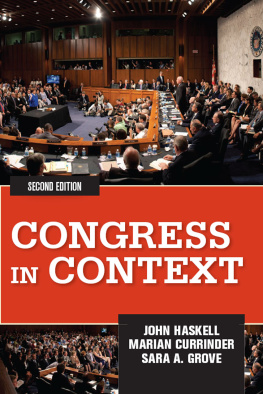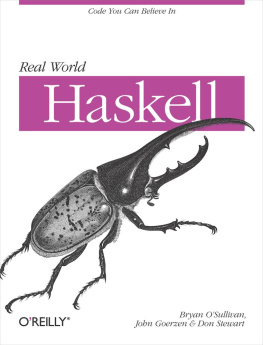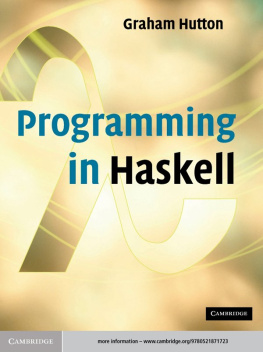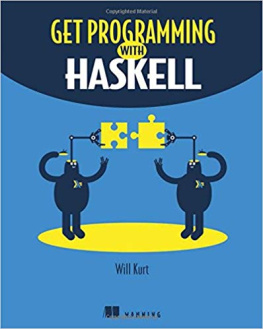First published 2014 by Westview Press
Published 2018 by Routledge
711 Third Avenue, New York, NY 10017, USA
2 Park Square, Milton Park, Abingdon, Oxon OX14 4RN
Routledge is an imprint of the Taylor & Francis Group, an informa business
Copyright 2014 Taylor & Francis
All rights reserved. No part of this book may be reprinted or reproduced or utilised in any form or by any electronic, mechanical, or other means, now known or hereafter invented, including photocopying and recording, or in any information storage or retrieval system, without permission in writing from the publishers.
Notice:
Product or corporate names may be trademarks or registered trademarks, and are used only for identification and explanation without intent to infringe.
Every effort has been made to secure required permissions for all text, images, maps, and other art reprinted in this volume.
Designed by Cindy Young
Library of Congress Cataloging-in-Publication Data
Haskell, John, 1959
Congress in context / John Haskell, Marian Currinder, and Sara A. Grove.Second edition.
pages cm
Includes bibliographical references and index.
ISBN 978-0-8133-4756-1 (pbk.)ISBN 978-0-8133-4758-5 (e-book) 1. United States. Congress. 2. Legislative powerUnited States. 3. Representative government and representationUnited States. I. Currinder, Marian. II. Grove, Sara A. III. Title.
JK1021.H38 2014
328.73dc23
2013036925
ISBN 13: 978-0-8133-4756-1 (pbk)
The unifying concept of this book is that Congresss central function in our separated system is to be, borrowing from James L. Sundquist, the board of directors of the federal government, empowered by the Constitution to authorize, fund, and supervise the activities of the governmentthat is, the executive branch agencies. As the lead author, I draw on my varied experiences as a college professor, a congressional staffer, and an instructor for federal agency personnel to produce a textbook that seeks to help people make sense of Congress in the context of its role in our separated system of government. The aim of Congress in Context is to convey my experiences working in government and with government officials, informed by the relevant political science literature, in a format that is lively and conveys a real-world sense of the first branch.
The journey that led to writing this book was a long one. I first taught a university-level course covering Congresscalled Congress and the Presidencyas a graduate student in the fall of 1986. The sections on the two branches were clearly differentiated in the syllabus. Overall, the course was presented as a series of topicsthe Congress in The Federalist Papers, congressional elections, leadership and committees in Congress, then the president in the Constitution, presidential personality, presidential elections, and so forth. As a grad student, I was too wrapped up in other more pressing matters to impose much organizational coherence on the course. To be honest, it never occurred to me to do that. The syllabus was handed down, as it were, and I did as I was told.
When I moved on to full-time teaching and a tenure-track job, my portfolio included separate courses on Congress and the presidency. I continued to teach Congress more or less as a set of differentiated topics, albeit with an introduction emphasizing that members have two roles, legislative and representative. Generally speaking, students seemed to enjoy the course, but I still did not impose the kind of structure or coherence that the material deserved.
One year I had the good fortune to work on Capitol Hill through the American Political Science Association Congressional Fellowship Program. From day one of my assignment, I was disturbed to find out how ignorant I had been about what members of Congress and their staff were up to on a day-to-day basis. I knew almost immediately that I had been stressing the wrong things in my Congress course, or at least had not been conveying to students what really mattered about the institution. At first I could not put my finger on exactly what I had missed. Eventually, my thinking began to crystallize: what members were doing was primarily aimed at changing government programs and agency policies and practices to the benefit of their constituents in particular, and sometimes to the benefit of broader groups across the country. I was in dozens of meetings involving a wide range of members and staff. Although a lot of these meetings were primarily political, even those usually touched at least a little bitand often much more than thaton what the members could do in law or by other means to change federal programs to the peoples benefit.
This realization changed the way I taught Congress when I returned to the classroom. I covered the same main topicselections, committees, party leadership, and so forthbut changed the focus to looking at congressional policy making in the context of the institutions role in the federal government. I began to stress that Congress matters to the extent that what it does in law and through other methods alters or creates government programs that invariably have tangible effects on peoples lives. Understanding how a bill becomes a law has intrinsic importance only insofar as a law may change, for example, Interior Department policies that affect the management of federal lands or the populations of endangered species, or as a law may involve funding one type of research instead of another at the National Institutes of Health (NIH).
In 2000 I landed a job at the Government Affairs Institute at Georgetown University. GAI has a unique mission among nonprofit educational institutions: it endeavors to explain how Congress works to executive branch officials. The notion is that the government functions better when the people who work in the two branches understand each other. Executive branch officials are in constant communication with members of Congress, and especially congressional staff, but most of them have trouble mastering the specialized lingo, understanding the complex authorization and appropriations processes, and grasping members perspective on the world. This is where GAI comes in.
Teaching federal agency personnel about Congress brings into clear relief the most salient function of Congress: directing, through legislation and oversight, the work of the agencies and departments of government. It is tremendously important for executive branch officials, students at the undergraduate and graduate levels, and interested citizens to understand the legislative process and what drives members decision making on Capitol Hill. After all, government programs as created by Congress and administered by executive branch officials have a profound effect on all of our lives. The federal government now constitutes well over 20 percent of the American economy, and it is unlikely to get smaller or less significant. It is Congress that provides the statutory basis for the work of the agencies. Understanding congressional policy making tells us a great deal about the kind of government we have now and will have in the future.











![Will Kurt [Will Kurt] - Get Programming with Haskell](/uploads/posts/book/116897/thumbs/will-kurt-will-kurt-get-programming-with-haskell.jpg)

